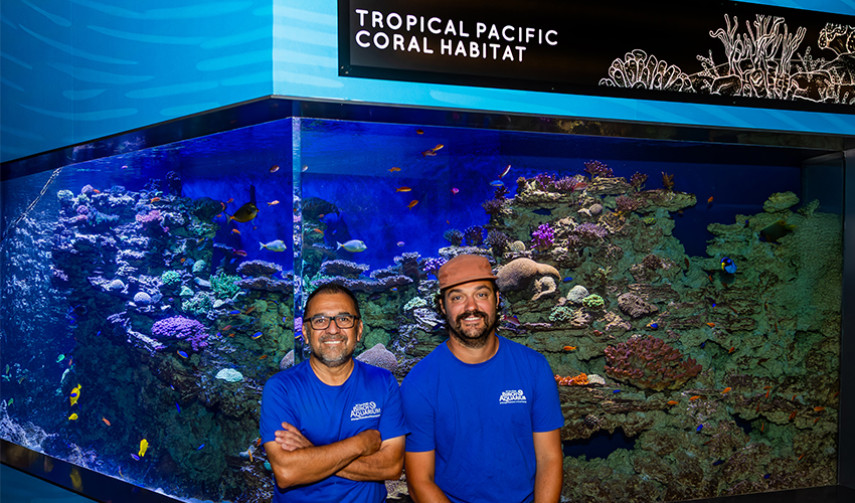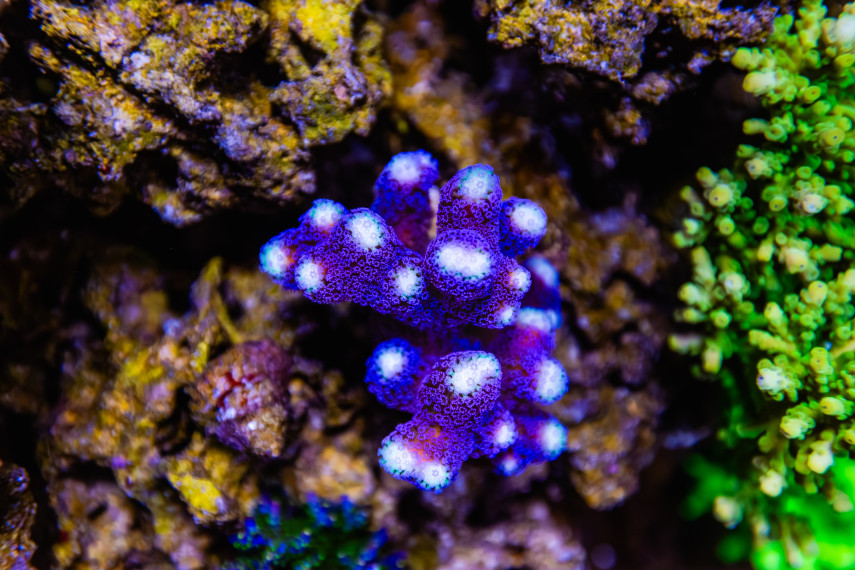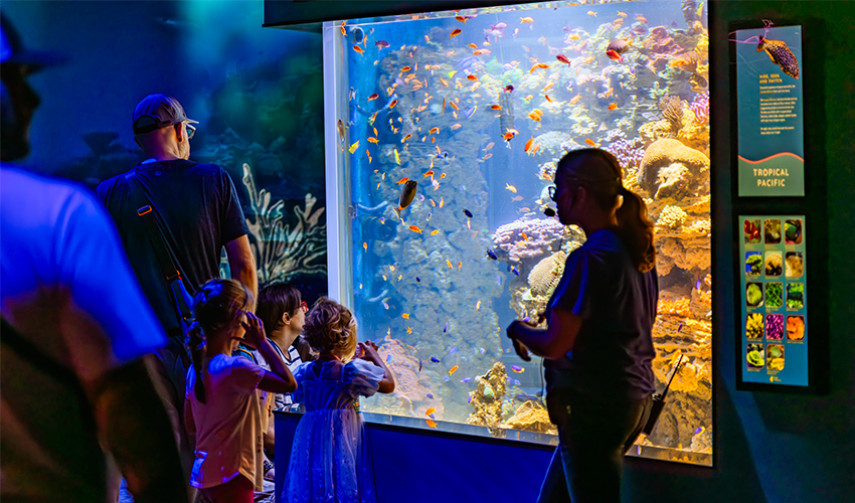This Coral Reef Awareness Week, Birch Aquarium at Scripps Institution of Oceanography at UC San Diego is celebrating some coral conservation wins thanks to the new Tropical Pacific Coral habitat in Adam R. Scripps Living Seas Gallery.
Now nearly six times larger than the previous coral display, this expansive habitat immerses guests in a vibrant underwater world teeming with colorful corals, Giant Clams and tropical fish. But the impact goes far beyond size and beauty!
“Bringing this habitat to life required tremendous work, and we’re thrilled with how it all came together,” said Fernando Nosratpour, Associate Curator.

Sustainable Design in Mind
From early concept sketches and clay models to hauling more than 4.5 tons of rock to build the reef structure and finally carefully placing each coral by hand, our dedicated Coral Care Team poured their hearts into every detail.
Their goal? To create an immersive journey through the three main zones of a coral reef — the fore reef, reef crest and back reef — as guests explore the habitat. It’s now home to around 35 different coral species, with plans to welcome a few more in the near future.


“If you look closely at the clay model, you’ll notice small colored beads — each one represents a different coral species. We placed them to mimic where those corals naturally occur on a reef,” said Nosratpour. “That layout helped guide our lighting and flow design, and gave us a sense of how many corals we’d need to fill out this reef.”
It also features energy-efficient pumps and programmable LED lights that help us better replicate natural reef conditions — all while advancing the aquarium’s long-term sustainability goals. Thanks to this thoughtful design, the team is already seeing promising signs that the habitat is thriving.
Spotted: Baby Coral
The Coral Care Team recently discovered baby Pocillopora Coral — commonly referred to as Cauliflower Coral — growing near the top of the reef, a promising sign of a healthy habitat! This type of hard coral can reproduce both asexually and sexually and is known for its surprisingly fast reproductive cycle. With spawning events occurring nearly every month, it’s often one of the first corals to settle on a reef.


Most corals are colonial, meaning thousands of genetically identical polyps live together in a connected group to form large structures. This baby Cauliflower Coral started as a single primary polyp just a few weeks ago, but over time, it will grow as new polyps form from existing ones. Right now, it’s about the size of a marble — but one day, this coral could grow as large as a dinner plate!
Room to Grow
The Coral Care Team has also observed impressive growth in several other coral species, including Stylophora Coral — also known as Cat’s Paw Coral. The bright white tips on these corals are a sign of healthy new growth (not to be confused with the white appearance that occurs during coral bleaching). These signs of new growth are exciting indicators that the coral habitat is thriving.
Though coral reefs are known for their beautiful color, the tiny animals that build them — coral polyps — are actually clear or white. Their vibrant colors come from a symbiotic relationship with microscopic algae called zooxanthellae, which live inside the coral and provide energy through photosynthesis. Corals also produce “accessory pigments” that further enhance these stunning colors.

When designing the new habitat, the Coral Care Team anticipated they would need to support a much larger and diverse coral collection. Fortunately, they had already laid the groundwork!
“Seeing the success of species like our Cat’s Paw coral reflects years of careful propagation and dedicated behind-the-scenes care,” said Nosratpour.
For years, the team has been carefully propagating a variety of coral species behind the scenes to grow and strengthen the aquarium’s collection. This effort not only increases genetic diversity but also supports critical scientific research and helps reduce pressure on wild coral reefs.
Catch a Coral Feeding
“Coral reefs are like underwater cities – bustling, interconnected and essential to ocean life,” said Mollie Beth Samocha, Interpretive Programs Coordinator.
This new habitat at the aquarium offers an exciting chance to connect guests directly with ongoing coral conservation efforts through the new Coral Feeding presentation. During these talks, aquarium educators reveal the hidden world of corals, showcasing how these tiny but mighty animals build the foundation of entire ocean ecosystems.

“We also highlight how scientists at Scripps Oceanography are developing innovative ways to support coral resilience — from lab-based restoration techniques to understanding how reefs respond to climate change,” continued Samocha. “These efforts, combined with daily specialized care here at the aquarium, demonstrate how protecting coral ecosystems helps ensure a healthier future for us all.”
Interested in joining the next Coral Feeding? Guests can check the Daily Schedule at aquarium.ucsd.edu to find out when the next one takes place.
About Birch Aquarium at Scripps